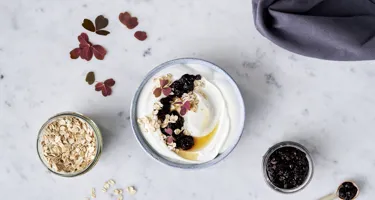
In the land of dairy products, skyr is an Icelandic wonder. It has a smooth, creamy consistency and a mild yet refreshingly tangy flavour profile, making it a versatile dairy delight. It is traditionally enjoyed for breakfast or served as a dessert, often accompanied by fresh fruits or a touch of honey to enhance its subtle, fresh taste.
What is skyr yogurt?
At first glance, you might mistake skyr for Greek yogurt, thanks to its thick, creamy texture. However, the resemblance ends there. Technically, skyr is a type of cheese made from the process described below.
How to make skyr
The process of making skyr is a time-honoured tradition handed down from generation to generation in Iceland. The name is not a protected title, so there are various ways to make it, but typically, the first step is to pasteurise skimmed milk and remove the fat. Then, active cultures are added, and the mixture is left to ferment until it thickens.
Once the fermentation process is complete, the mixture is cooled and then meticulously strained to remove the whey, which is the watery part of milk. This straining process is what makes skyr thicker, creamier, and more concentrated than regular yogurt.
The tradition of skyr
Originating from the rugged landscapes of Iceland, skyr dates back to the Vikings. Yes, you read that right. The tangy, creamy, yogurt-like product has ancient Viking roots. The Nordic explorers discovered that through fermentation, they could create a product that not only tasted delicious but also had a remarkably long shelf-life.
It is believed that the Vikings brought the method for making skyr with them from their travels more than a thousand years ago, but over the centuries, it has become an Icelandic staple and woven itself into the fabric of Icelandic culture and tradition.
What is the difference between skyr and yogurt?
While both are cultured dairy products, they are, in fact, quite different from one another. The primary difference between the two lies in their production methods and the specific types of bacteria used for fermentation.
Traditional yogurt is produced by fermenting milk with a combination of two specific bacteria – Lactobacillus bulgaricus and Streptococcus thermophilus.
Moreover, in the production of skyr, the whey is strained off to a greater extent than with traditional yogurt, resulting in a thicker, creamier product. And from a nutritional standpoint, skyr generally packs a higher protein punch than regular yogurt due to its dense, concentrated nature.
Skyr yogurt protein content
Skyr is a high protein product as 100 grams of skyr contain about 9-11 grams of protein. For example, Arla fat-free skyr contains 10 grams of protein per 100 grams, resulting in an energy contribution of 59%. However, the exact values vary depending on the brand and the specific product.
Is skyr fermented?
Yes, skyr is a fermented product. Typically, the production process involves adding live active cultures to milk, which ferments the lactose (milk sugar) in the milk, producing lactic acid. This lactic acid gives the characteristic tangy taste and helps coagulate the proteins in the milk, contributing to its thick texture.
Fermentation also plays a key role for the texture. Skyr has a notably thick and creamy consistency, akin to Greek yogurt but denser. This is a result of the fermentation process, which, along with the straining of whey, helps to concentrate the proteins.
Choose between a true classic or a new creamy delight
At Arla, the celebration of both old and new has never tasted so good. We offer you a tantalising choice between a tried-and-true fat-free skyr and a extra creamy variant.
Rooted deep in the heart of tradition, Arla® fat-free skyr is an Icelandic-style yogurt that is thick, creamy, and bursting with the natural flavour that skyr enthusiasts have come to know and love. With a texture perfect for incorporating into your cooking and a 0% fat content, it is a delightful treat allowing you to indulge in the rich taste.
With a nod to the Icelandic tradition of adding a dash of cream to the traditional darling, we bring you a new, extra creamy skyr. Maintaining the signature thickness of the original skyr, the addition of cream transforms this delicacy into a lush, full-bodied creamy delight with 5% fat. Offering a mild, pleasantly wonderful taste and a satisfying texture that is both thick and incredibly creamy, this new take on skyr proves that it is possible to revamp a classic.
How to use skyr for a high-protein meal
One of the easiest ways to incorporate it is by using it as a substitute for other dairy products. Its dense and creamy texture makes it a perfect replacement for crème fraiche, cream cheese, mayonnaise, and the like.

For instance, consider mixing it with a squeeze of lemon, fresh herbs, and a pinch of salt for a dip or spread for your sandwiches. You can also add it to your favourite smoothie without it overpowering the other flavours.
Additionally, skyr can be used to make a protein breakfast. Pair it with whole grain cereal or muesli, topped with a handful of your favourite nuts and seeds. Not only does this meal provide a good dose of protein, but it also brings together a mix of flavours and textures that can kick-start your morning.

How to eat skyr
For a simple yet wholesome breakfast, try eating it straight from the container with a spoon. It has a mild tangy flavour that is perfectly enjoyable on its own. If you prefer a subtle hint of sweetness, consider adding a drizzle of honey or a sprinkling of cinnamon.
It also works excellently in a smoothie, lending a smooth, thick texture and a tangy note to balance the sweetness of fruits and berries. Blend with bananas, strawberries, or blueberries. Finish off your smoothie with a dash of honey or a sprinkle of chia seeds, and you have a quick, delicious breakfast to-go.
If you enjoy baking, you will be delighted to know that skyr can find a place there too. It can be a substitute for fats like butter or oil in many baking recipes. Not only does it provide moisture, much like fats do, but it also contributes to a tender texture in the finished product. Consider making whole grain muffins with spinach and cheese, adding skyr to the batter. These make for a great breakfast or snack on-the-go.
If you want to know more about the Icelandic dairy delight and how to incorporate it into your cooking, look at our article cooking with yogurt
Skyr FAQs
Each pot of Arla Skyr is:
- Naturally high in protein
- Made from skimmed milk
- Reduced in sugar*
Discover the benefits of Arla Skyr for yourself, whether you’re waking up your taste buds with a refreshing bowl topped with berries, or tucking into a high-protein snack as part of your working day or after your yoga class.
*30% less sugar vs other flavoured yogurts based on a market average.
Yes, traditional Icelandic Skyr is made from skimmed cow’s milk – so that’s exactly how we make Arla Skyr, staying true to the traditions that have given Skyr its reputation over the years. Each tub contains as much as four times the volume of milk found in regular yogurts, which is the secret to its lusciously thick, scoop-able texture.
Yes, Arla Skyr is made from pasteurised, skimmed milk.
Of course! It’s cool and refreshing, with a tang that makes your taste buds buzz. But a spoonful of Skyr is so much more than that. It’s thick and super-silky – a real guilt-free addition to your day that sets you up for whatever lies ahead.
Arla Skyr is an Icelandic-style yogurt that is made with skimmed milk, whereas Greek style yogurt is traditionally made with full fat milk. The two are similar in other respects though, both championing the luscious, thick texture which leaves an imprint when you scoop. To find out more, read our Skyr vs Greek yogurt article.
Skyr and Quark are similar in some ways. Both have that lusciously thick texture that sets them apart from regular yogurts. However, there are some notable differences:
- Origin - Skyr has its origins in Iceland, while Quark has Slavic roots.
- Flavour – you’ll taste more of a familiar, yogurt tang with Skyr, compared to the mellow flavour of Quark.
- Ingredients – Skyr is made using skimmed milk, which makes it fat-free. Quark can be made using a range of different milks, from skimmed to whole. To find out more, read our Skyr vs Quark article.
Skyr is all the best parts of yogurt with a whole lot more besides. It’s thick, creamy, naturally higher in protein, fat-free and reduced in sugar. It’s also nourishing, thick and incredibly refreshing.
Discover the full range of Arla Skyr and experience it for yourselves.






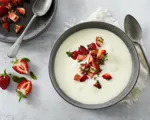






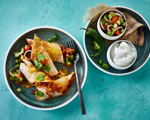
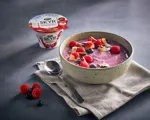



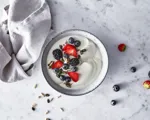


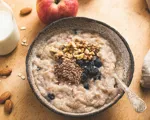

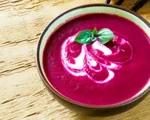












&format=webp)








